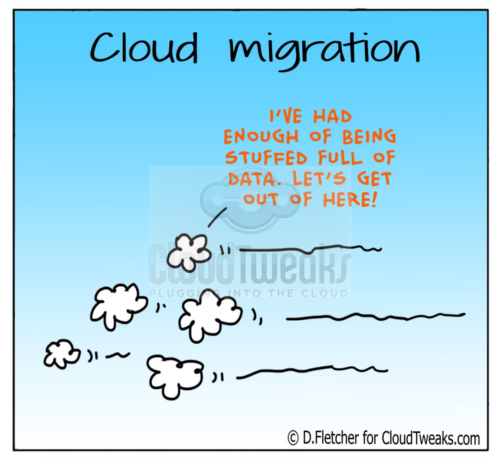The global pandemic witnessed the digital transformation of businesses in the cloud. Today, even as the world resumes to normal, the end-to-end innovation in business strategies has kept the momentum going as the demand for a self-servicing cloud platform continues. More and more companies are reinventing their cloud approach to become cost-efficient and agile so businesses can scale and operate regardless of location and device. As the pandemic proved, cloud computing helps businesses navigate uncertainty and remote work culture. It also highlighted the importance of replacing legacy infrastructure with a device and location agnostic ecosystem.
As Cloud Migration becomes a trendy movement among small and big businesses, the need arises to achieve optimal benefits of cloud computing while matching the business needs.
Businesses need to consider the following challenges:
What Cloud Migration strategy to adopt? Which best practices to implement?
How to achieve a seamless and efficient Cloud Migration? What tools to use?
Every cloud expert must address these questions. And the best way to learn cloud adoption strategies is to opt for cloud architect bootcamp from a premier institute. You can learn all about effective Cloud Migration Monitoring and earn a certificate to add value to your resume.
Companies saddled with inefficient infrastructure and aging servers look at Cloud Migration to reap the benefits of cloud computing technologies. While some make a partial migration, many others go for a complete migration of their digital assets, IT resources, services, databases, and applications. This movement of on-site IT assets, from private servers and in-house data centers to the virtual cloud architecture, is Cloud Migration. It also includes migration from one set of cloud services to another.

Various Cloud Migration strategies exist for different workloads and Cloud Migration plans. But how to know which Cloud Migration strategy works best?
Cloud experts adopt any or some of the Cloud Migration strategies listed below, known as the 6 Rs:
Each has its own merits and considerations that are factored in when deciding upon the strategy to adopt.
When carefully planned and executed, Cloud Migration can achieve many real-time efficiencies.
Some of the key benefits of migrating to the cloud include:
Cloud Migration is a complex process that must be planned and strategized in detail. As businesses face various challenges of on-premise and legacy infrastructure, they are looking for ways to migrate their operations and applications to the cloud. However, the choice of the Cloud Migration approach comes with its challenges.
Some of the key challenges include:
Financial concerns are dealt with an incremental migration shift, batch adoption, or hybrid cloud adoption. But skill shortages are met only by hiring cloud experts qualified in various Cloud Migration strategies.
For Cloud Migration success, these challenges have to be managed by expert cloud professionals who monitor the migration process end to end. It requires continuous performance monitoring through all the stages, from planning to execution and beyond. Cloud Migration Monitoring begins before the migration plan and continues during and after the migration process to achieve performance visibility in the cloud for all applications migrated. IT assets stored on-premise can be monitored easily. However, when they migrate to a cloud environment with visibility gaps, they require in-depth monitoring and evaluation at all stages of the migration. Monitoring also includes powerful insight into performance issues for total control and visibility into the user experience.
Moving large amounts of data is a process that rarely goes flawlessly from the beginning, and you don’t want to find problems once the process is over.
Most businesses have moved some of their operational systems to the cloud. Cloud and DevOps professionals are critical to migration projects acting as facilitators and monitors during the migration. A flawless migration requires monitoring the applications at every stage – when they are running on-premise, during migration, and when the workload is running in the cloud.
This guide walks you through your cloud migration roadmap. Plan your monitoring strategy. Identify the various elements to monitor. And learn ways to make your cloud migration strategy a success.
Having a business plan is known to mitigate risks. And this is equally true for the successful monitoring of Cloud Migration. It includes getting familiar with the architecture of the cloud system you are migrating to, the dependencies, resource utilization, and hardware limitations. All this is part of a Cloud Migration strategy where knowing what to migrate is as important as monitoring the process.
Monitoring occurs at every stage of a Cloud Migration:
After planning, is the execution and monitoring of the Cloud Migration Project.
Cloud Migration is a complex process, where each migration is unique based on the business problems and challenges to be met with the migration. Based on the migration goal, different metrics are set up as baselines.
Each business has different requirements from the cloud platform. However, most Cloud Migrations have similar areas that require attention during Cloud Migration monitoring.
The critical areas that require monitoring are:
The correct infrastructure usage is one of the first things to be monitored, as some dependencies and processes change depending on the platform used. Monitoring ensures that the placement of IT assets is smooth without bottlenecks or silos. It helps ensure that the correct balance of storage and processing power is used.
Observing the application traffic during the migration of your application validates application configurations and ensures their availability. Some migrations call for a closer look at the traffic and user interaction with the new cloud system. All requests arriving in the new server must be tracked for maintaining timely access and minimizing error rates. Additionally, response times to load your application must not exceed the stipulated performance benchmark. This aspect of monitoring is necessary for end-user satisfaction.
Monitoring and configuration of external applications ensure the seamless functioning of your solutions and business analytics. You need to monitor how well these apps communicate with the new cloud platform.
One of the business goals for moving IT assets to the cloud is to use available resources without incurring additional overhead costs. It makes necessary the tracking of the financial aspect of Cloud Migration. Incorrect or hasty implementation of Cloud Migration may lead to bottlenecks or higher resource use. But monitoring costs can help understand any unplanned expenses or unexpected losses.
Many cloud storage providers offer dedicated first-party tools that monitor costs on the go. These tools integrate into the migration pipeline and help visualize cost data in dashboards for continuous monitoring and alerts. They help to keep checks on cost escalations and understand the areas of expense.
The security of the system and migration of applications is a primary concern when moving IT assets from in-house data centers and servers to the cloud. The process of migration means exposure to security vulnerabilities. Such security incidents can occur during or after the migration process. So monitoring of security parameters involves checking infrastructure configurations, the internal traffic, and processes accessing the services. Watching application programming interface hits per second can help discover if there is any distributed denial of service (DDoS) attack.
Monitoring requests within the network and adherence to security protocols are ways to ensure security during the entire Cloud Migration process.
Cloud providers offer various tools to ensure a seamless transition. The three cloud giants, AWS, MS Azure, and Google Cloud Platform, have free monitoring tools for your Cloud Migration monitoring needs.
Besides, you have third-party Cloud Migration tools like Cloudscape with solutions for monitoring integrations with your new platform.
Monitoring Cloud Migration is a business-critical process, and organizations are hiring IT and DevOps professionals with cloud-related skills. As new cloud platforms become more affordable, more and more businesses are migrating to the cloud and hiring skilled cloud experts to monitor the entire Cloud Migration process.
By Rahul Arun





